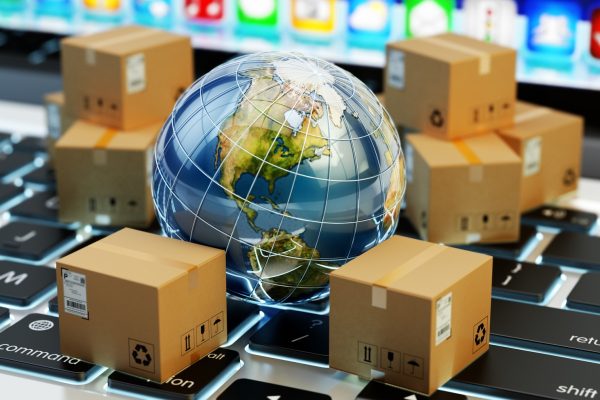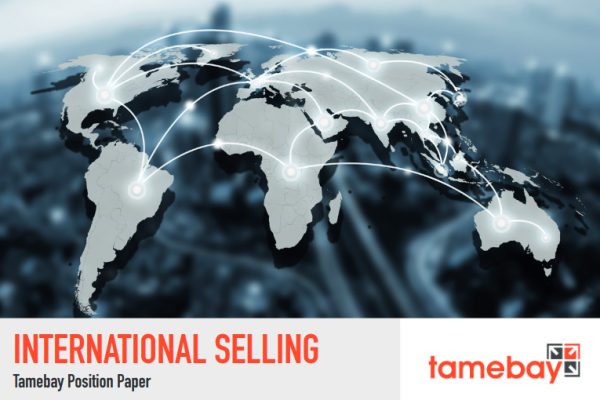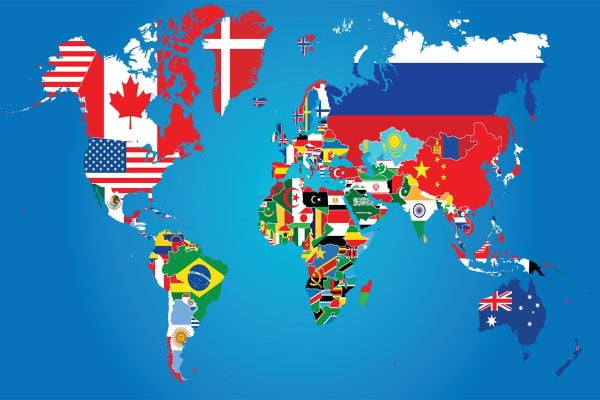Download or read online
This position paper on International Selling is available as a free download to read offline at your convenience, or carry on reading below.
International Selling
As an ecommerce enterprise develops, ambitious merchants soon discover that they outgrow their domestic market and sales growth starts to plateau. To find further growth, the obvious option is to look to countries overseas and tap into their online shopping market. But that is often easier said than done and establishing the processes and administration of selling internationally can prove to be complex. There is a lot to learn.
By far the easiest way to make inventory available to shoppers around the world is to use an online marketplace. In the first instance that means plugging into Amazon and eBay’s global network, but they don’t dominate every country. In Poland, for example, homegrown marketplace Allegro leads the field. In China, TMall dominates as the most popular online marketplace. Neither eBay or Amazon have a presence in Africa. Marketplaces are often also invaluable partners when it comes fulfilment and translation and they obviously take on the strain of marketing and can leverage their local knowledge to promote the goods for sale, which would be all but impossible for individual merchants selling from their own webshop.
There is no doubt that the best way to embark on your international selling adventure is to start with the major marketplaces such as eBay and Amazon. They’re both hungry to get new international selling and offering their goods to shoppers all over the world.
Where you decide to sell to will depend on your business ambitions and the products you sell. Some merchants start selling internationally from day one making it part of their start-up business plan. Others will want to become established domestically in the first instance before branching out to more exotic locales. Those decisions will depend on your level of confidence and expertise.
Remember that selling internationally doesn’t mean blanket trading with every country in the world. You can pick and choose the countries you want to trade with according to your business needs and the level of complexity your are willing to embrace. Product lines will also determine where you sell to. Some products are more popular in certain countries, for instance the Low Countries and the Nordics are keen buyers of British cultural goods such as music and books.
A methodical and analytical approach is desirable. The successful international merchant will embrace the analytical and monitoring tools available to test and learn and ensure that the time and resources expended are providing a return.
A disciplined approach is also required when considering the logistical aspects of selling overseas. Establishing process for shipping and fulfilment, taking payments and returns, paying your tax and duties as required and complying with local laws are all considerations merchants selling cross-border must address. And there are numerous sources of information and services available to aid you on your international journey.
The marketplaces don’t take care of all the logistics of selling globally, so calling on the services of other third-party suppliers will also be vital. Every ecommerce merchant presides over a “portfolio business”, buying in services from multiple providers, but international ecommerce merchants need to be at the centre of a more complex network as they administer successful international trade.
Assistance with language and translation is available, tax specialists to ensure you comply with local laws offer services specifically honed for marketplace sellers is out there, international shipping services can assist with fulfilment and you can even utilise warehousing solutions overseas to help get purchases to your customers more swiftly.
The benefits of selling internationally
There are multiple advantages to selling your goods internationally:
A bigger customer base
This one is obvious. By offering your products to other countries you greatly increase your potential customer base. That gives you the scope to make more sales. The total predicted sales for global ecommerce in 2021 is $4.5USD trillion.
The UK is the third biggest ecommerce market in the world, preceded by China as the largest and USA clocking in second. Japan is the fourth biggest ecommerce market. As a single bloc, the member states European Union collectively offer a buying audience off over 250 million people.
Better margins
Not all countries have access to the plethora of consumer goods we take for granted in the UK so selling to foreign buyers can mean that you get better prices for your goods than you do from a domestic shopper. And don’t forget too that shoppers from other countries love British goods and brands.
The relative weakness of sterling since the Brexit referendum in 2016 has also provided some currency advantages when selling goods to customers overseas because you can maintain prices but offer a better deal, specifically to shoppers buying in euros.
Beat seasonality
Whether it is Single’s Day in China or Thanksgiving in the USA or Canada, there are all sorts of special occasions that spur people on to shop that we don’t have in the UK. Going global means you can exploit worldwide online shopping trends and make more sales.
Outsmart your competition
Selling internationally is challenging and presents some specific problems when it comes to logistics and business management and, as a result, many online merchants don’t sell overseas. If you are willing to take on some of the challenges of international selling then you can get a competitive edge.
International marketplaces
As an existing eBay or Amazon seller there are several ways that you can start selling with your existing registrations and make your goods available swiftly to a global audience. The selling tools available to Amazon sellers are universal and similar but eBay, which has more country specific marketplaces, does have greater international variance with rules and practices varying by location.
Selling internationally on Amazon
Amazon operates country specific marketplaces in the US and UK, Germany, France, Spain, India, Japan, Mexico, Australia, Brazil and Canada. Of course, it has shoppers in many more countries who buy cross border from these marketplaces. If you’re registered as a seller in the UK, you are automatically permitted to trade on the other four European Amazon websites. If you are registered with Amazon in the United States, then you also get access to Amazons Canada and Mexico.
If you are not already registered, it’s worth remembering that it is not necessary to be a limited company. Sole traders are welcome too. The documentation you need to supply will depend on your status. For merchants based in the UK, to start selling on Amazon’s US marketplace, it is necessary to establish a distinct Amazon account. A separate email address is required but you can use all of the other information (including bank account) that you have on your UK login.
Amazon has a marketplace presence in Japan, too although it’s not a service many European merchants utilise. Like with amazon.com, an additional email account is required to establish a new account as well as your business details. Japan is a big market with a great love of British goods and brands, especially fashion and music. So it is well worth exploring, although postage costs to Asia can sometimes make exports prohibitively expensive. The language barrier with Japan is alleviated because merchants can administer an amazon.jp account in English using an English language Seller Central.
Selling internationally with Amazon FBA
Fulfilment by Amazon (FBA) is a service whereby Amazon holds stock on a seller’s behalf and despatches it as if it were their own. It’s a useful service for Amazon sellers who want to start selling to overseas customers because stock can be lodged in Amazon’s warehouses around the globe for quicker despatch to customers in that country. This means that you can offer super-quick despatch from within the country your buyer lives. You can also send your goods to fulfilment centres in the USA.
Amazon also offers a pan-EU FBA service that helps merchants get goods to European buyers more quickly and easily. You send a single shipment to Amazon and then they split it up amongst different fulfilment centres in the various European countries depending on their knowledge of how much will sell and where.
Remember, it’s not necessary to put all your stock, or even all your lines, into Amazon FBA. It can be be entirely flexible to your needs. Because FBA attracts a fee (roughly 30% of sale price) it’s a good idea to use it for your best selling, best margin items.
Creating international listings on Amazon
Once registered and up and running, the next step is making inventory available to international shoppers. If you already have inventory on Amazon UK you can easily get those set up on an international marketplace using the Build International Listings feature Amazon provides. You can find the tool in Seller Central.
Amazon works on a catalogue basis which means that if an identical product is available on an overseas marketplace then you can attach your inventory to the relevant listing at the click of a button. Amazon will also help with pricing as currency exchange rates fluctuate or you may want to engage an international repricing too to help you get the best prices.
Amazon can also help with internationalising your listings and translate your inventory descriptions from and into English, French, German, Italian and Spanish. Not all verticals are included and it’s a bespoke service for which you must apply for a price.
When it comes to cataloguing your sales, especially if you’re selling unique goods that you brand or produce yourself, you’ll need a unique product identifier (ASIN, GTIN, barcode etc.). Such things are reasonably inexpensive but avoid cheap offerings. The official provider of barcodes is GS1 and they are the only supplier that Amazon recognises. Failing to use correct product identifiers could cause you to be sanctioned by Amazon.
Selling internationally on eBay
By far one of the best ways to grow your eBay business is to offer your products to shoppers overseas. And on eBay there are a number of different ways to approach this challenge. eBay claims to have buyers in 190 countries around the globe and has over 30 dedicated national marketplace websites.
eBay’s Global Shipping Programme
By far the easiest way to start selling internationally is by using the Global Shipping Programme (GSP). You need to tick this option in your selling tool and then eBay make your chosen inventory available to buyers in the countries that use GSP. The beauty of the programme is the ease.
As a seller, all you need to do is ship the goods to a UK depot and eBay do the rest. They then forward the package to the buyer, who has already paid an additional fee to cover the postage. Once the parcel is received safely in the UK warehouse, you’re home and dry. eBay will cover you and fulfil the item. It’s a no-brainer option and the easiest route to international selling on eBay. If the goods don’t get to their international destination, eBay won’t sanction you and you want get poor DSRs as long as you got the parcel to eBay safe and sound.
Use your eBay Shop international selling allowances
One of the of the major benefit of an eBay Shops subscription comes in the form of a clutch of international listings as part of the package. If you have an eBay Shop then you should exhaust this before you do anything else. This offers you listings on the local sites in the local currency. The number of free listings will depend on which Shops subscription you have.
Sell directly on international eBay sites
It may be that you have inventory that will perform particularly well on a particular international marketplace. In this case it can be worth creating a bespoke presence on there and even create a local eBay Shop. Many advanced sellers will have multiple Shops on different sites to amplify their profile. Taking this approach will require that you localise your listings. That won’t be a problem for english-speaking eBay marketplaces in Canada, USA and Australia but it could mean more work for major eBay sites in France and Germany, for instance. Such internationalisation is something you can do your self if you, or someone on your team, has the adequate expertise in language and local markets. Or you can engage a specialist firm who can help. The cost will depend on the quality of the service and scale of the task.
Selling on other global marketplaces
There is more to global marketplaces than eBay and Amazon. There are hundreds of of different marketplaces available specific to individual countries. You can find out more in our Tamebay marketplaces section.
Many of these international marketplaces are keen to attract sellers from outside their own country because it helps them broaden their product choice for consumers. Such is the scope and choice in international marketplaces that it’s impossible to give specific advice on where to start. They have numerous selling models, means of fulfilment and pricing structures. For many, just like with Amazon, you’ll need to apply to sell and get approval.
Service providers for international merchants
Part of finding success as an international online retailer is harnessing the help that’s available out there to create an effective selling machine. Nobody has all the experience and skills necessary to manage a business that’s selling to multiple countries, dealing in various currencies and conversing in numerous languages. But for every problem, there’s a solution.
The marketplaces do provide expertise and help. And reputable multichannel software provider will often prove to be valuable source of advice regarding essential services to grease the wheel of international trade. Attending events for ecommerce merchants can also be a very useful way of getting the latest information in what’s an ever changing ecosystem. Obviously here at Tamebay we like to share information about interesting and reputable international providers but the best sources of information are the merchants already selling successfully. Where possible, try and tap up the experts doing it already to get the best knowledge.
Here are some of the available services as you trade:
International shipping, fulfilment and returns
One of the biggest concerns when trading internationally will be fulfilling your orders. Most reputable courier firms and carriers offer international tariffs and those which you choose to go with will depend on what you’re selling and what you want in the way of insurance and protection. International shipping rates vary but it’s still possible to find carriers for heavy and oversized items to almost anywhere in the world.
Often in these cases a shipping broker, a service that aggregates the multiple different services available, is a good option because they will be able o advise on the various and often changing rates and services available from a whole host of providers.
Foreign exchange services
Dealing in multiple currencies is one of the aspects of international trading that offers an opportunity. By engaging a specialist firm to help you, it could be that you can save money by offering preferential exchange rates. The banks aren’t honed to providing the services that an ecommerce business needs and are often not competitively priced. Specialist firms can help you with a number of tasks. They can collect your money overseas without the need for a bank account. They can also provide you with fixed exchange rate products to help you plan. And they can help you pay suppliers overseas. There are a number of firms out there who can help, you just need to choose the one that suits you.
Tax advisors
Even if you’re just trading within the confines of the EU, there will be issues regarding tax that need to be addressed. In particular, sales taxes such as VAT need to be accounted for. This could be a complex area to understand but services out there exist to take the pain out of paying your way. Amazon also has a service that helps you file your tax returns in the EU.
What to sell and where is a crucial aspect of being a successful merchant, but how do know what’s going to make the best return on your investment of time and money? You need to crunch the data and there are tools available that will help and ensure that you’re not flying blind. They combine historical data and competitor intelligence to inform your stock buying choices and maximise margins. You can use a third-party service or your multichannel software partner, such as ChannelAdvisor, may have an analytics tool included in the package.
Overseas customer support
Amazon expects sellers to be fastidious in their dealings with buyers. One stipulation is that sellers respond to buyer emails within 24 hours or otherwise receive a penalty. It’s hard enough to deal with the emails in your native language but doing it in multiple foreign tongues requires help. There are companies that specialise in providing such a service. And don’t forget, if you use FBA, Amazon deals with the customer service side of things also.
International returns
Many marketplaces, including Amazon, require sellers to offer a returns service to buyers, even if the transaction is cross border. This represents a headache for merchants, especially when selling relatively low value items. If the cost of a return is greater than the value of purchase, then the cost becomes prohibitive. Consider a service that makes a merit of this problem. You can engage a firm to take a return in the USA, for instance. They don’t send the item back but rather take the return themselves and sell it again, on your behalf, or hold onto your goods until you have a consignments that is economic to ship back. Such returns services, ZigZag international is the best known, can minimise your loss.
Global Choices
Don’t bite off more than you can chew as you start selling overseas on Amazon, eBay or other marketplaces. There’s lots to learn and it’s best to take baby steps to start with. Start with a few key lines and gradually ramp up your activities. And make it easy on yourself by starting with the EU in the first instance. It’s easy to make your products available within Europe and shipping is straightforward too.
What about Brexit?
As it stands at the moment, the EU still remains a vital arena for ecommerce despite impending Brexit as the UK leaves the European Union. And it’s now clear that the there is going to be no change to trading terms between the UK and EU until the very end of 2020. The UK will remain part of the customs union and the single market until that time and there will be no barriers to trade until then.
As to what happens after that, is not entirely clear. But several things seem apparent. Is it worth waiting to find out and potentially miss out on several years of trading with Europe as we wait for answers that might be a long time coming. Tamebay’s expectation is that the marketplaces will find ways to solve most of the problems and grease the wheels of EU-UK trade: it’s in their interest to make things as easy as possible and they do have some clout to make a difference.
And Brexit is also a spur to merchants to look beyond the EU to further future proof international sales. Brexit won’t immediately impact sales outside the EU to places like the USA and Canada, so opening up those channels before Brexit could also be a winning strategy for selling cross-border.









